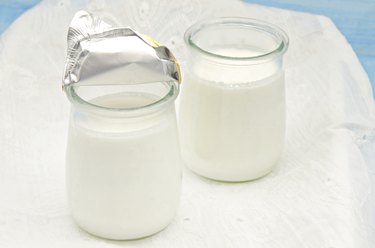
When evaluating your diet, calories aren't the only factor to consider. Also worth noting is the glycemic index of your food, which indicates the speed at which a particular food raises your blood sugar. High-glycemic foods cause a rapid spike in your blood sugar, while those with a low glycemic index cause a slower increase. Enjoying a bowl of plain yogurt won't cause a rapid blood sugar response.
The GI of Plain Yogurt
Video of the Day
Foods with a glycemic index of 55 or less are considered low, and plain yogurt has a glycemic index of 14. By comparison, fruit yogurt has a higher glycemic index due to the added sugar and the fruit in the yogurt, but still ranks on the low end of the scale at 36.
Video of the Day
Combine Yogurt and Fiber
Eating plain yogurt and other foods with a low glycemic index is ideal, as a diet heavy in high-glycemic foods can cause not only high blood sugar, but can also increase your risk of getting Type 2 diabetes. If you don't favor the taste of plain yogurt, pair it with a high-fiber food such as an apple. The apple provides sweetness, while its fiber helps fill you up without causing a rapid blood sugar increase. High-fiber foods have low glycemic indexes because fiber slows the absorption of the food.
Protein and Other Benefits
Plain yogurt is also a source of protein, which plays an important role in functions such as cell growth. The protein in plain yogurt varies according to its type. Plain, low-fat yogurt has about 8.9 grams of protein per 6-ounce container. Plain Greek yogurt is higher in protein, with about 17.3 grams of protein per 6-ounce container. Adult men and women need 56 and 46 grams of protein, respectively, per day. Yogurt is also a source of vitamins, minerals such as calcium, and probiotics, which are healthy bacteria that benefit the body.
Glycemic Index of Dairy Products
Plain yogurt has a lower glycemic index than many other dairy products. Its glycemic index is lower than milk; whole milk has a glycemic index of 30 and skim milk has a glycemic index of 32. When manufacturers add sugar to other dairy products, the glycemic index quickly increases. For example, custard and ice cream have rankings of 43 and 60.
- DiabetesNet.com: Glycemic Index
- Eat Right Ontario: Getting to Know the Glycemic Index
- MedlinePlus: Protein in the Diet
- U.S. Department of Agriculture National Nutrient Database for Standard Reference: Yogurt, Plain, Low Fat, 12 Grams Protein Per 8 Ounce
- U.S. Department of Agriculture National Nutrient Database for Standard Reference: Yogurt, Greek, Plain, Nonfat
- Centers for Disease Control and Prevention: Protein
- Montignac Method: The Factors that Modify Glycemic Indexes
- Canadian Living: The Health Benefits of Yogurt